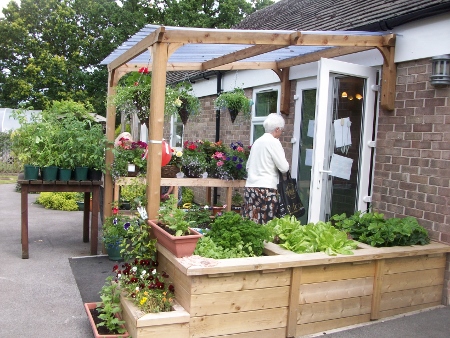A new guide has been published aimed at helping providers of dementia care environments to enhance services by maximising access to outdoor space. Here, co-author, DR GARUTH CHALFONT, tells BBH about the importance of therapeutic design
Body text:Access to outdoor spaces is vital when creating healing environments for people with dementia, according to new guidance.
Dr Garuth Chalfont, a leading practitioner in the art and science of healing gardens, therapeutic spaces and dementia gardens, is the co-author of the Dementia Green Care Handbook of Therapeutic Design and Practice.
The document aims to demonstrate the positive impact of using therapeutic approaches connected to nature and the outdoors to benefit the lives of people with dementia. It includes ideas for practical and easily-achievable interventions that will enhance all sorts of care settings.
Alex Walker, former associate director of NHS Central Lancashire, who helped to produce the guidance, said: “For too long, people with dementia have been overly defined by their health condition, which has resulted in care often concentrating on the problems and deficits that can result from dementia, rather than encouraging the strengths and abilities people retain.
“The structure of service delivery in more enhanced care settings, in particular, often means that people spend the vast majority of their lives indoors, losing contact with the natural world around them.
For too long, people with dementia have been overly defined by their health condition, which has resulted in care often concentrating on the problems and deficits that can result from dementia, rather than encouraging the strengths and abilities people retain
“Nature and open spaces retain familiarity and a sense of enjoyment for nearly all people and our connection to them is elemental.”
The handbook is aimed at managers, owners and operators of care homes, nursing homes and day care facilities, as well as architects, landscape architects and service commissioners.
Speaking to BBH about the guidance, Dr Chalfont, who is a landscape architect, said: “People with dementia are often distressed and this can lead to behaviour that challenges the caregiver. We have found through our work that just getting people outside for a short while and getting them out of their rooms or off the unit is hugely beneficial. It can improve sleep, promote a better appetite, and can make people less reliant on medication.”
The handbook highlights several projects across the UK where access to the outdoors has been enhanced for people with dementia. For example, the garden at the Charnley Fold mental health resource centre in Lancashire has been redeveloped into an all-weather oasis.
Manager, Julie Newton, said: “I am convinced this model of green care enhances health and wellbeing, increases opportunities for purposeful activity, and promotes communication between partners.”
The guidance provides an overview of both passive spaces, which are not designed to be used by people, but to provide a pleasant view and a glimpse of wildlife; and active spaces, which encourage people to get outdoors and take part in various tasks.
It states that a successful therapeutic space can be created by making activities such as watching and encouraging wildlife, tending and cultivating plants and seeds, and playing games or exercising routinely possible.
Gardens should also have direct access from internal communal areas; should be located at the south, east or west sides of the buildings; and should be visible from windows. Balconies, terraces or roof gardens help to provide an oasis for residents on the upper floors of buildings, and gardens should be level so as to make navigation easier, with raised beds which residents can reach.
If using pathways, these should not lead to a gate or door people are not allowed to use as this can create anxiety, and all turns should be wide enough to accommodate two people side by side or a person in a wheelchair.
Addressing the issue of risk, which is often a barrier to the creation and regular use of effective outdoor spaces, the guidance states that many care home gardens are designed to be so low risk that they are ‘useless therapeutically’.
Nature and open spaces retain familiarity and a sense of enjoyment for nearly all people and our connection to them is elemental
“While a certain amount of caution is necessary if you are to provide a duty of care, what usually happens is that no risk is allowed anywhere, so residents are condemned to a life of boredom and under-stimulation, which logically can lead to so-called challenging behaviour.
“A garden with the lowest level of risk fails those with the highest level of need.”
Case studies within the guidance include research undertaken at The Lodge, a specialist dementia care facility in Chorley, Lancashire, run by Hica Care Homes, where external spaces have been enhanced to encourage more outdoor activity.
As a result of the intervention more residents went outside during the day, with many increasing in confidence and venturing further afield with staff, for example to the shops, supermarket or local pub. In addition, staff became more aware of the positive benefits of helping people to get out and about.
And this is the key to an effective project, according to the report, which advises that staff engagement is crucial to success.
“As staff gain confidence in their ability to manage taking people out, they have also been able to take people further afield,” it states.
“As staff come back with their success stories, this is a great boost for morale and good practice. This can only help to dispel the stigma in society around dementia and distressed behaviour.”
Dr Chalfont said: “I don’t think enough attention is paid to outdoor spaces and there is much more than can be done.
“A lot of this is about changing the attitudes of staff and showing them what is possible. We need to change the whole culture and if we take that risk we can make dementia care environments great.”





